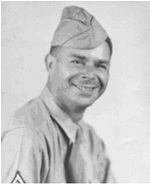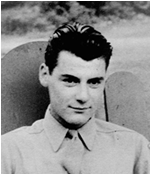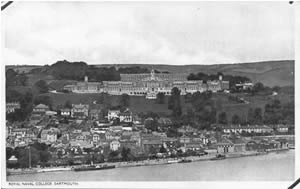Brightwood Boys, The History of the Men from
the North End of
Springfield, Massachusetts,
During World War II
by Christopher P. Montagna
CHAPTER 12 - Part 2
A TRICKY ENLISTMENT
 At 35-years-old, Joe was the eldest of the Montagna brothers. Like Serafino, the family patriarch, Joe was making his living as a fruit vendor. He began his career working for Mario Marchetti. Having established a clientele, he began his own fruit and vegetable venture in the mid-1930's. On October 20, 1943, Joseph Montagna was inducted into the Army.
At 35-years-old, Joe was the eldest of the Montagna brothers. Like Serafino, the family patriarch, Joe was making his living as a fruit vendor. He began his career working for Mario Marchetti. Having established a clientele, he began his own fruit and vegetable venture in the mid-1930's. On October 20, 1943, Joseph Montagna was inducted into the Army.
That same day, Army Pfc. Richard Messenger embarked aboard a troop ship for his overseas duty. Richard “Dick”  Messenger, the son of Herbert and Thelma Messenger, lived at 79 Springfield Street. His father was the chief engineer at the Springfield Hospital. Dick Messenger enlisted in the Army on May 12, 1943 and reported for active duty seven days later on May 19, 1943. Due to his civilian occupation as a photostat operator, he was detailed as a photographer. On October 21, 1943, Dick departed for the European Theater of Operations and arrived in England on November 2, 1943. He was assigned as a photographer with Headquarters Detachment - Technical Service Forces.
Messenger, the son of Herbert and Thelma Messenger, lived at 79 Springfield Street. His father was the chief engineer at the Springfield Hospital. Dick Messenger enlisted in the Army on May 12, 1943 and reported for active duty seven days later on May 19, 1943. Due to his civilian occupation as a photostat operator, he was detailed as a photographer. On October 21, 1943, Dick departed for the European Theater of Operations and arrived in England on November 2, 1943. He was assigned as a photographer with Headquarters Detachment - Technical Service Forces.
 On November 10, 1943, Joe Montagna reported for active duty and began basic training at Fort Devens, MA. Joe completed his technical training as a combat engineer at Camp Swift, Texas. Upon completion of tech school, Joe was assigned as a truck driver with Company C of the 277th Combat Engineer Battalion with the rank of Technical Corporal.
On November 10, 1943, Joe Montagna reported for active duty and began basic training at Fort Devens, MA. Joe completed his technical training as a combat engineer at Camp Swift, Texas. Upon completion of tech school, Joe was assigned as a truck driver with Company C of the 277th Combat Engineer Battalion with the rank of Technical Corporal.
The 277th Combat Engineer Battalion was organized October 25, 1943 at Fort Swift, TX. The cadre was obtained from the 56th Armored Engineer Battalion, Camp Barkley, TX and fillers obtained through the selective service act by transfer from other units and voluntary enlistment. The majority of the enlisted men came from New England.
Joe Montagna’s 277th Combat Engineer Battalion was stationed at Fort Pickett in Virginia from July 9, 1944 to October 6, 1944 and assigned to the 1142nd Engineer Combat Group. While at Camp Pickett, members of the 277th Combat Engineer Battalion learned to construct Bailey bridges. The Bailey bridge was a portable pre-fabricated truss bridge, designed for use by military engineering units to bridge up to 60 m (200 foot) gaps. It required no special tools or heavy equipment for construction, the bridge elements were small enough to be carried in trucks, and the bridge was strong enough to carry tanks.
Meanwhile, in the pacific, on November 10-11 1943, Sonny Diamond was aboard the USS Denver as it supported landing operations on Cape Torokina. Two days later, during a heavy air attack, the USS Denver was hit by an aerial torpedo, which knocked out all power and communications and killed 20 of her men. The following is from the After Action Report was filed Lt. Cdr T. R. KURTZ, Captain of the USS Denver:
At 4:50 am the ship made contact on three or four enemy planes. The planes began coming in for torpedo attack. The Denver commenced firing Anti-Aircraft battery and automatic weapons at enemy aircraft. At 4:54 the U.S.S. Stanley reported that a torpedo was going by her side headed towards the Denver. The Denver began evasive action, however, before completion of this turn, the ship was hit by an aerial torpedo. The torpedo struck the starboard side of the Denver.
The gun crews of the Denver shot down two enemy aircraft at the start of the attack and one more after completion of attack by the Task Force. When attack by enemy low flying planes was first detected, one group of at least four (4) were sighted on starboard quarter, in the vicinity of a rainsquall. Fire was opened with 5" and one (1) plane seen to crash immediately. Observed two (2) torpedoes dropped, estimated distance 1500 yards. The Captain of the Denver ordered hard left rudder just before U.S.S. Stanly reported torpedoes. The fourth plane swung wide around squall and headed in towards the Denver, under heavy fire of A.A. from ships in the vicinity and plane dropped torpedo at 750 yards and turned across Denver’s bow and crashed 1000 yards to port. Third plane seen to crash after heavy automatic fire from U.S.S. Stanly.
During the attack, Earl Diamond suffered a contusion to his head as a result of the torpedo blast. Earl was treated and retained aboard ship. The Denver was towed by the USS Sioux to Port Purvis and then by the USS Pawnee to Espiritu Santo for temporary repairs. The Denver sailed to Mare Island in California for permanent repairs, arriving on January 2, 1944.
On November 28, 1943, Adam Montagna departed from Lido Beach, NY for England aboard the HMS Aquitania. While Adam was sailing aboard the Aquitania for his overseas duty, Nino Montagna embarked a designated U.S. Naval LST and sailed from Goodenough Island, D’Entrecasteaux Island Group on December 3, 1943. He arrived and disembarked at Nascing Alatu, New Guinea on Dec 5, 1943.
 On December 11, 1943, Adam arrived in Firth of Clyde, Scotland. In November 1943, an advanced party of American Servicemen from Scotland arrived on the windswept Kingswear platform. The vacated Royal Naval War College, Dartmouth, Devonshire, England became the U.S. Navy’s Advanced Amphibious Base, and Staff Headquarters of the flotilla of landing craft, including Landing Craft for Infantry (LCI), Landing Ship Tanks (LST) and Landing Craft Tanks (LCT) on December 24, 1943. The newly established base would be Adam’s home for the next thirteen months.
On December 11, 1943, Adam arrived in Firth of Clyde, Scotland. In November 1943, an advanced party of American Servicemen from Scotland arrived on the windswept Kingswear platform. The vacated Royal Naval War College, Dartmouth, Devonshire, England became the U.S. Navy’s Advanced Amphibious Base, and Staff Headquarters of the flotilla of landing craft, including Landing Craft for Infantry (LCI), Landing Ship Tanks (LST) and Landing Craft Tanks (LCT) on December 24, 1943. The newly established base would be Adam’s home for the next thirteen months.
Two days after Adam reported to his new duty station, Nino participated in landing operations against enemy forces (Japanese) at Cape Gloucester, N.B. on December 26, 1943. Nino would spend the next four months taking part in offensive and defensive operations against enemy forces at Cape Gloucester, N.B.